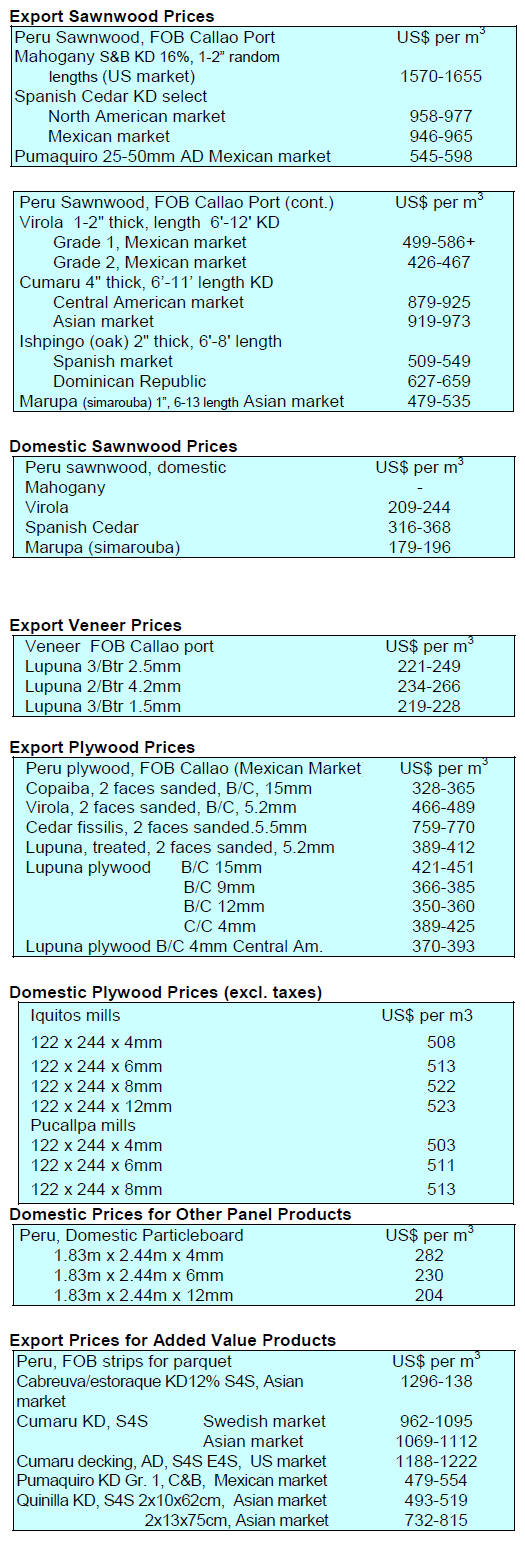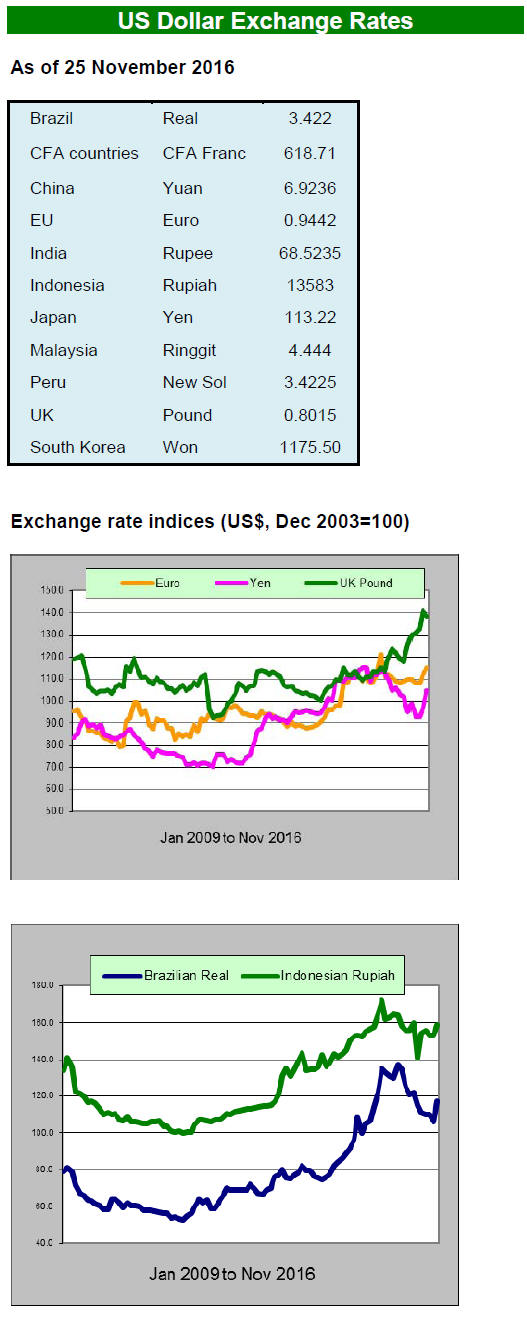2. GHANA
Roadmap to revitalize forest resource
sector
The Minster for Lands and Natural Resources, Prof. Nii
Osah Mills, has launched a three pronged strategy
designed to address the challenges facing the country¡¯s
forest and wildlife sectors.
The strategies are set out in the ¡®Ghana Forestry
Development Master Plan¡¯, the ¡®Ghana National REDD
(Reducing Emissions from Deforestation and forest
Degradation) Strategy¡¯ and the ¡®Ghana Forest Plantation
Strategy¡¯. The aim is to transform the natural resource
sector.
The Forestry Development Master Plan is a 20-year
Action Plan, designed to fully implement the 2012 Forest
and Wildlife Policy, which has shifted the focus from
over-reliance on timber revenues to conservation of
biodiversity and increased revenues from eco-tourism and
payment for eco-system services.
The Forestry Development Master Plan provides a sound
basis for attainment of the aims of the Forest and Wildlife
Policy and its successful implementation could maximise
the rate of social and economic development in the
country.
The Ghana National REDD Strategy aims at assisting the
country to prepare itself for reducing emissions from
deforestation and forest degradation and to position the
country for the implementation of an international
mechanism for REDD.
The Ghana Forest Plantation Strategy details how the
government and private sector can reforest degraded forest
lands by developing commercial forest plantations of
recommended exotic and indigenous tree species at an
annual rate of 20,000.
VPA legislation ready for parliamentary discussion
Additionally, the strategy targets the maintenance and
rehabilitation of an estimated 235,000 ha of existing forest
plantations as well as enrichment planting of 100,000 ha
of under-stocked forest reserves with high value
indigenous timber species over the same period.
Representatives of Ghana and the European Union met 18
November 2016 in Accra to review progress on the
implementation of the Ghana-EU FLEGT Voluntary
Partnership Agreement (VPA), which aims to improve
forest governance and verify the legality of Ghana¡¯s
timber trade.
A Ghana-EU VPA Joint Monitoring and Review
Mechanism (JMRM),which includes representatives of all
stakeholder groups, oversees the implementation of the
Agreement.
A recent meeting the JMRM reviewed the status of
development of Ghana¡¯s timber legality assurance system
and discussed outstanding issues to be addressed before
FLEGT licensing can begin. When issued, the FLEGT
license will enable Ghana¡¯s timber products to enter the
EU market without importers having to do further due
diligence to meet their obligations under the EU Timber
Regulation.
Musah Abu-Juam, Technical Director of Ghana Ministry
for Lands and Natural Resources presented the draft
legislation which will be submitted to Ghana¡¯s Parliament
for enactment. When this legislation is adopted Ghana¡¯s
forest governance will be enhanced and it will pave the
way to meeting the terms of the VPA.
In addition to this development Musa said Ghana was
addressing the illegal trade in timber in the domestic
market through a new system for tracking timber in the
domestic market which involves both suppliers and
traders.
Benoist Bazin, Team Leader for Infrastructure and
Development at the Delegation of the European Union to
Ghana said ¡°These major achievements show that Ghana
continues to strengthen forest governance through the
VPA and is advancing toward FLEGT licensing.¡±
See: https://eeas.europa.eu/delegations/ghana/15525/ghana-andeuropean-
union-advance-in-joint-effort-to-improve-forestgovernance-
and-combat-trade-in-illegal-timber_en
Bank of Ghana lowers interest rates
The Monetary Policy Committee of the Bank of Ghana
(BoG) has reduced the base rate by 50 points to 25.5% and
this has sparked dismay as a 100 point reduction was
anticipated but even this small cut comes as a relief to the
private sector. Ghana¡¯s interest rates are currently one of
the highest in the world.
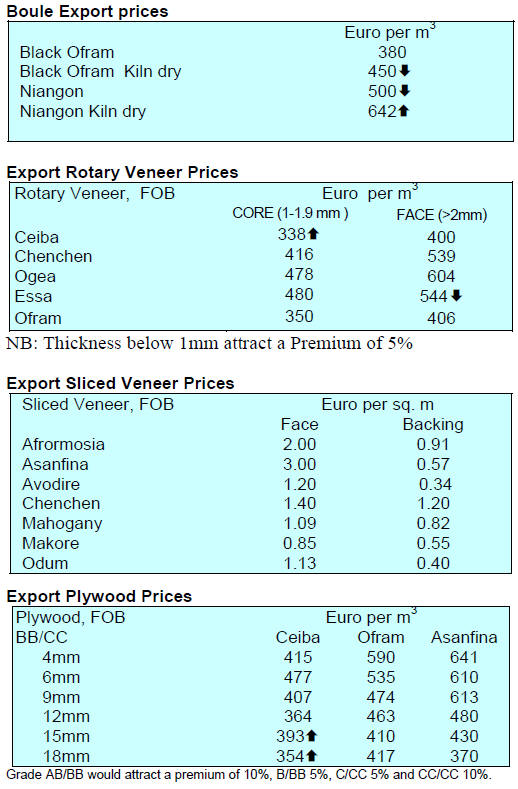
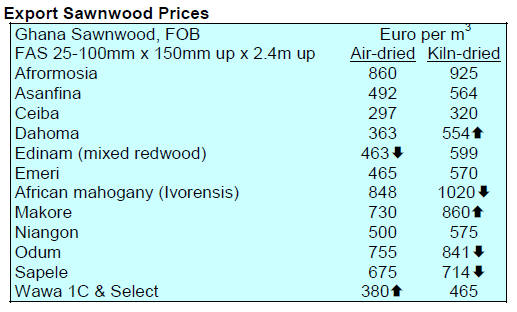
3.
SOUTH AFRICA
Meranti imports affected by container
shut-outs
Most of the discounted stocks of the bankrupt Zikiza have
been sold and as meranti imports begin to arrive once
more importers are raising their prices. Demand for
hardwoods is steady, say local traders. The main problem
at the moment is that shipments are being delayed because
containers are being shut out at the port of origin.
American hardwoods are selling well but because of
extended lead times in American sawmills both the level
and mix of stocks has been disrupted. There is firm
demand for white oak at present and analysts anticipate
firmer prices in the coming weeks.
Panel market slow as year-end holidays approach
Over the past weeks the plywood market has become
tighter because of a supply problem due to operational
difficulties at the new plywood mill at York Timbers. This
has driven some end-users to switch to OSB for which
importers have adequate stocks.
The panel market is expected to remain slow but steady
for now as activity in the construction and building sectors
winds down in readiness for the December holidays.
Some construction projects are set to begin early next year
but these have not yet been firmed up so suppliers are
waiting to see how the market will develop. Much
depends on industry sentiment which could be impacted
by the economic rating agencies assessment of prospects
in South Africa. If there are negative reports then some
projects are likely to be delayed.
Overall, the board market is steady with both particleboard
and MDF moving well. There has been some upward
pressure on prices as no discounted items are up for sale
and because deliveries have slowed.
Pine prices holding up despite weaker than expected
demand
Although the pine market is down about 5% year on year
in terms of volume, prices have not dropped due to low
stocks at the local mills. Analysts do not expect this to
improve until the beginning of the new year at the earliest.
Some pine products are imported from Zimbabwe and
shippers there have begun accepting Rand rather than
requiring US dollars. This has helped importers but the
problem is that production in Zimbabwe is erratic mainly
due to unstable power supplies.
Rosewood and teak fall out of fashion
In the South African market rosewood and teak are slow
movers at present as they both appear to be out of fashion.
On the other hand, demand for Kiaat (muniga) is good but
supplies are tight especially given the security issues in
Mozambique.
The decking market is steady but, given the weaker
exchange rate, some buyers are looking at local products
such as pine and eucalyptus. Shipments of sawn sapele
and okoume are landing but traders say okoume is still
priced higher than meranti.
Economic assessment - government construction
projects could be delayed
Business Monitor International (BMI) has released its
latest ¡®South Africa Infrastructure Report¡± and the BMI
website in introducing the report says ¡°We maintain our
tepid growth outlook the South African construction
market between 2016 and 2025 as political and economic
headwinds take hold.
Business confidence in the economy remains low,
hampering the outlay of much-need private investment
into infrastructure, while budgetary pressures are
hindering the government's ability to deploy the capital
earmarked for the sector.¡± The conclusion of the BMI
analysis is that growth will not expand significantly in
2017 and the government will find it increasingly difficult
to find the funds to finance all planned construction
projects.
For more see: http://store.bmiresearch.com/south-africainfrastructure-
report.html

4.
MALAYSIA
MTC leads mission searching for raw
materials
The Malaysian Timber Council (MTC) will accompany
several of the large timber manufacturers in the country on
a mission to Chile and Brazil.
The mission has two main aims, building business to
business ties and identifying potential raw material sources
for Malaysian companies. The mission is part of the
Council¡¯s Raw Material Augmenting Supply Programme.
The delegation will comprise eight timber companies
interested in sourcing tropical timber as well as plantation
resources for downstream processing in Peninsular
Malaysia.
In a press release MTC, CEO Dr. Abdul Rahim Nik said
¡°We want to introduce new timber species to the market
which can be used as an alternative supply to raw
materials and to value-add and diversify our product
range¡±. The delegation plans to visit production plants in
Chile and Brazil to discuss processing practices and seek
new business opportunities.
Malaysia reaffirms its commitment to sustainable
forest conservation and management
At the twenty-second session of the Conference of the
Parties (COP 22in Marrakech) Natural Resources and
Environment Minister Dr Wan Junaidi Tuanku Jaafar
reaffirmed Malaysia¡¯s commitment to sustainable forest
conservation and management.
The Minister said Malaysia has an ambitious REDD+
Strategy to address forest management issues and looked
forward to accessing the international finance and support
required for its implementation.
The Minister reported that extreme weather events were
already affecting Malaysia. One such event was the 2014
floods that devastated entire settlements in several States
with losses estimated at US$250 million and affected two
million people.
Wan Junaidi reminded the meeting that developed
countries needed to take the lead through reducing their
domestic greenhouse gas emissions to provide the
momentum for other countries efforts.
Heart of Borneo conference: Conservation through
Science-Policy Interface
The eighth International Conference on Heart of Borneo
was held in Kota Kinabalu, Sabah. The focus of the event
was implementation of Sabah's Heart of Borneo Strategic
Plan of Action.
The Sabah Forestry Department, organiser of the event, set
the theme as "Enabling and Empowering Conservation
through Science-Policy Interface, Conservation Finance
and Community Engagement."
During the opening of the conference, Sam Mannan, Chief
Conservator of Forests Sabah, charged participants with
the task of making conservation efforts effective and how
to scale up such efforts.
See: http://www.forest.sabah.gov.my/mediacentre/
broadcast/events/568-hob-conference-2016
Plywood.
Plywood traders based in Sarawak reported the following
export prices:
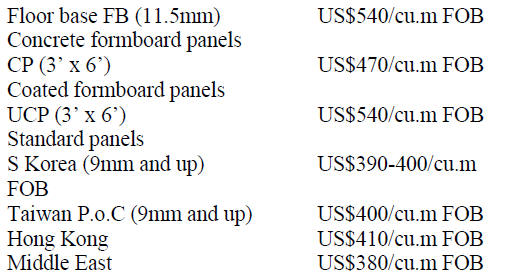
5. INDONESIA
Singapore, Indonesia move to boost trade
ties
Singapore is looking to enhance cooperation with
Indonesia through investments beyond traditional
destinations, increasing tourist traffic and by setting up a
business council involving both countries.
A joint statement from Indonesian President Joko Widodo
and from Singapore¡¯s Prime Minister Lee Hsien Loong
provided details of plans to strengthen economic
cooperation. Last year, Singapore invested US$5.9 billion
in Indonesia making it Indonesia¡¯s biggest source of
foreign investment. Investments have grown this year with
Singapore investing over US$7 billion in Indonesia within
the first nine months.
Noting the private sector¡¯s involvement in economic
projects between the two countries, the two leaders
concluded that the best way forward is to provide a
platform for business people to get together and meet
regularly. To achieve this it was decided a
Indonesia/Singapore business council should be created.
See more at: https://www.gov.sg/news/content/today-online---
singapore-indonesia-move-to-boost-tradeties#
sthash.XsIZ9nhb.dpuf
FAO applauds Indonesia¡¯s success with FLGT
licensing scheme
In a press statement posted on its website FAO welcomed
the first shipment of FLEGT-licensed timber to the
European Union (EU). Indonesia is the first country to
have successfully concluded all the requirements of the
EUTR and through this has contributed to global efforts to
stamp out illegal logging and promote the legal timber
trade says FAO.
The FLEGT license opens up a ¡®green lane¡¯ for timber
being imported to the EU, one of the world's largest
consumers of timber products.
FAO writes, ¡°Indonesia¡¯s FLEGT-licensing scheme is
based on the country¡¯s Sistem Verifikasi Legalitas
Kayu (SVLK), or timber legality assurance system, which
ensures that timber has been harvested, transported,
processed and traded according to Indonesian law.
Under the scheme, all wood-based product types listed in a
Voluntary Partnership Agreement (VPA) between
Indonesia and the EU and directly exported to European
markets must now be accompanied by a FLEGT license
issued by an Indonesian licensing authority. In turn,
importers can place it on the market with no additional
checks.¡±
See: http://www.fao.org/in-action/eu-fao-flegt-programme/newsevents/
news-details/en/c/452397/
Consumer spending holding up well
A recent analysis from Focus-economics says Indonesia¡¯s
economy slowed in the third quarter due to sluggish
exports and a fall in investment. On the other hand
domestic consumption held up well, which bodes well for
growth in the final quarter of the year.
However, at some point consumer confidence is likely to
be dented as the currency weakens, imports become more
expensive and manufacturing output falls with a knock-on
impact on wages.
For more see:
http://www.focus-economics.com/countries/indonesia
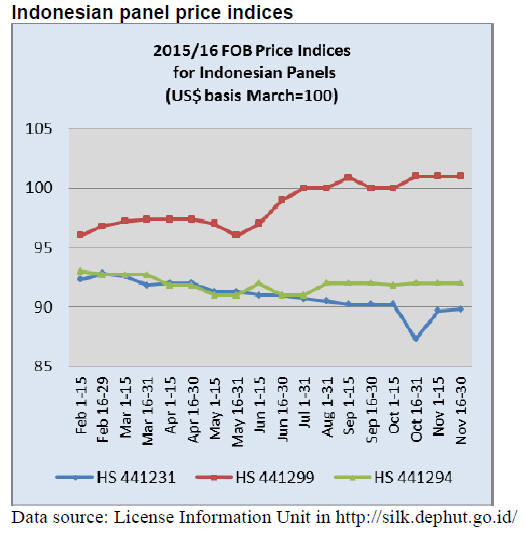
Sustaining economic reforms
The government of Indonesia will soon release its 15th
economic policy package in an effort to maintain the
momentum of structural reforms and encourage
investment.
According to Darmin Nasution, Minister for Economic
Affairs, the 15th policy package will begin dealing with
deregulation, improving the investment climate,
infrastructure developments and manufacturing.
Peatland villages to aid restoration
The provincial government of Jambi will establish a
number of village communities in areas where fires have
destroyed the forest and severely affected the underlying
peat. The village community will be advised on peatland
management and supported in the establishment of cash
crops and eventually tree crops.
Nazir Foead of the Peatland Restoration Agency said it is
vital to speed up the peatland restoration programme to
ensure this unique eco-system survives. It has been
estimated that of the 900,000 ha. of peatland almost
200,000 ha. has been burnt.
6. MYANMAR
Merchants Federation says it can deliver
details of
timber origin
The Forestry Department has issued a statement on the
Swedish court decision that resulted in a fine for a
Swedish importer for failing to satisfy the due diligence
requirement of the EU Timber Regulation in relation to a
shipment of Myanmar teak.
The Forestry Department has admitted that when
shipments comprise timber from multiple sources and
these sources are not separately identified then the chain of
custody (CoC) can fail. The statement said that efforts are
underway to devise a system that can provide accurate
CoC details.
At the same time, the task force comprising stakeholders
preparing for the VPA with the EU has issued a statement
saying that they can respond to requests for information on
shipments from buyers. The point of contact is the
Myanmar Forest Products Merchants Federation
(MFPMF, a private sector federation which issues the
Myanmar ¡®Green Folder¡¯). The MFPMF said they will
respond with information on the timber origin in
cooperation with the Forestry Department and the
Myanma Timber Enterprise.
Container trucking restricted in Yangon
New traffic regulations in Yangon by which the movement
of container trucks will be restricted to only between 9pm
and 6am is likely to cause problems and raise transport
costs in the timber industry.
Under the current Forestry Regulations a forestry official
must be present at the mill when the container is sealed.
This means a container must arrive at a mill a day
earlier
so it can be loaded and inspected, Then the container must
be trucked overnight to arrive at the port before 6am.
In related news, to speed up export procedures, the
Ministry of Commerce has abolished one step in the
document process, the requirement that approval of the
contract price be secured in advance.
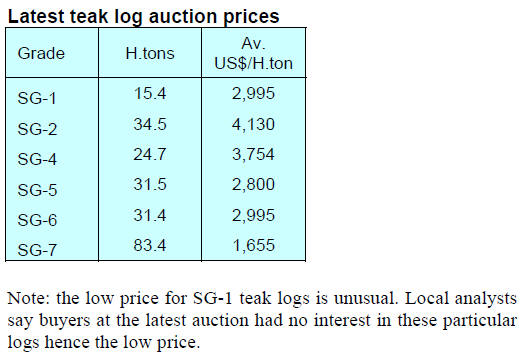
7.
INDIA
Currency swap fallout
A quick look at the responses from analysts to the
government¡¯s decision to eliminate high-value banknotes
from circulation suggests most are anticipating this will
have a negative effect on the economy for at least the next
12 months.
HSBC has written that GDP could fall from the 7% in the
first quarter of this year to around 6% over the next 12
months. This has been borne out as the Ratings Agency
Fitch said it anticipated a drop in growth in the fourth
quarter.
The immediate impact of the currency swap decision was
to undermine the rupee exchange rate. In mid-November
the rupee slid to a low of 68.86 to the US dollar despite
selling of US dollars by the Reserve Bank of India (RBI).
The RBI has estimated that by the end of the month just
7% of the 5 trillion rupees in 500 and 100 rupee notes
have been exchanged.
For more see:
http://www.nipfp.org.in/search/?q=currency+swap
Inflation rate trends
The Office of the Economic Adviser (OEA) to the Indian
government provides trends in the Wholesale Price Index
(WPI). The official Wholesale Price Index (WPI) for All
Commodities (Base: 2004-05=100) for October rose by
0.1% to 182.9 from 182.8 for September.
The annual rate of inflation, based on the monthly WPI,
stood at 3.39% (provisional) for the month of October
2016 compared to 3.70% for September 2015.
See:
http://eaindustry.nic.in/cmonthly.pdf
Timber and plywood price indices climb
The OEA also reports Wholesale Price Indices for a
variety of wood products. The Wholesale Price Indices for
WoodProducts and Plywood are shown below.
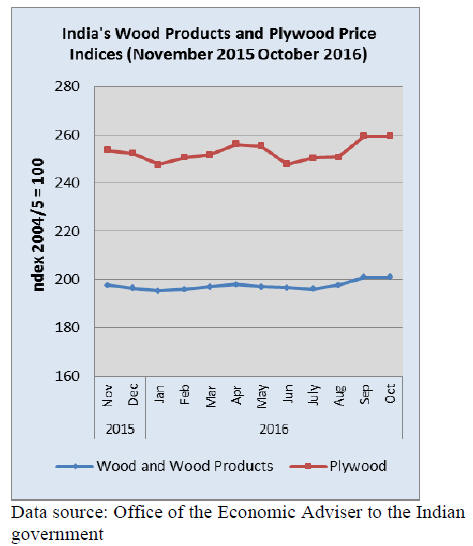
Procedures for wood industry license applications
streamlined
New regulations have come into effect making it easier
and faster for enterprises to obtain manufacturing licenses.
The changes are contained in the Wood Based Industries
(Establishment and Regulation) Guidelines, 2016 as
proposed by the Ministry of Environment, Forest and
Climate Change. These Guidelines are applicable in all
States andTterritories.
Prior to the introduction of these new guidelines to get a
license companies had to apply to the Centrally
Empowered Committee (CEC) located in New Delhi. This
had to be done through individual state/territory Forest
Departments. This often had to be followed up with costly
visits to the capital.
Now each State and Territory is required to constitute a
State Level Committee (SLC) to implement new
regulation and the SLCs are required to meet at least
once every three months.
The SLC will include one invited representative from
industry nominated by the state sawmillers association.
The SLCs are required to assess the availability of log raw
materials for every mill once every 5 years and decide
whether or not the mill should continue at its present
location or move to an area with a better supply of logs.
To determine the log raw materials available in a given
area the SLVs will commission studies in collaboration
with institutes/universities which will take into account the
volume of wood available locally as well as that coming
across state boundaries.
In the North Eastern States of Arunachal Pradesh,
Assam,
Manipur, Meghalaya, Mizoram, Nagaland, Tripura and
Sikkim wood based industries shall only be permitted
within industrial estates.
For mills utlising only imported logs the SLC will
determine the impact of these mills on the viability of
mills using domestic logs and if necessary move to protect
these mills.
Teak prices hold up well despite currency swap
turmoil
Auctions recently concluded in Surat and Bharuch as well
as the Vyara Divisions of Surat Circle have thrown up
surprisingly good results. Observers were expecting prices
to fall due to the ¡®cash crunch¡¯ in the country and the
general uncertainty in the industry but this was not the
case.
The log lots on offer were from various Departmental
forests, private forests as also from Forest Worker Co-
Operative Society forests.
With such a mix of sources it was anticipated that bid
prices would be highly variable and lower than usual but
this was not the case.
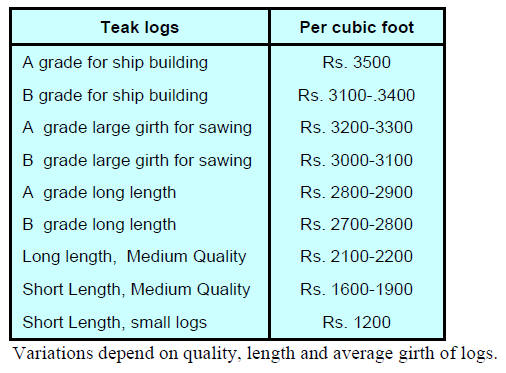
Prices for good quality non-teak hard wood logs
eased in
the recent auctions. Logs of 3-4 metres length having
girths 91cms and up of haldu (Adina cordifolia), laurel
(Terminalia tomentosa), kalam (Mitragyna parviflora) and
Pterocarpus marsupium attracted lower prices in the range
of Rs.800-900 per cu.ft.
For medium quality logs prices were from Rs.600-800 and
logs of average quality attraced just Rs.300-500 per cu.ft.
Plantation teak prices
Demand for planation teak continues to be good and in
recent shipments some suppliers have been providing
larger diameter log which has lifted prices.
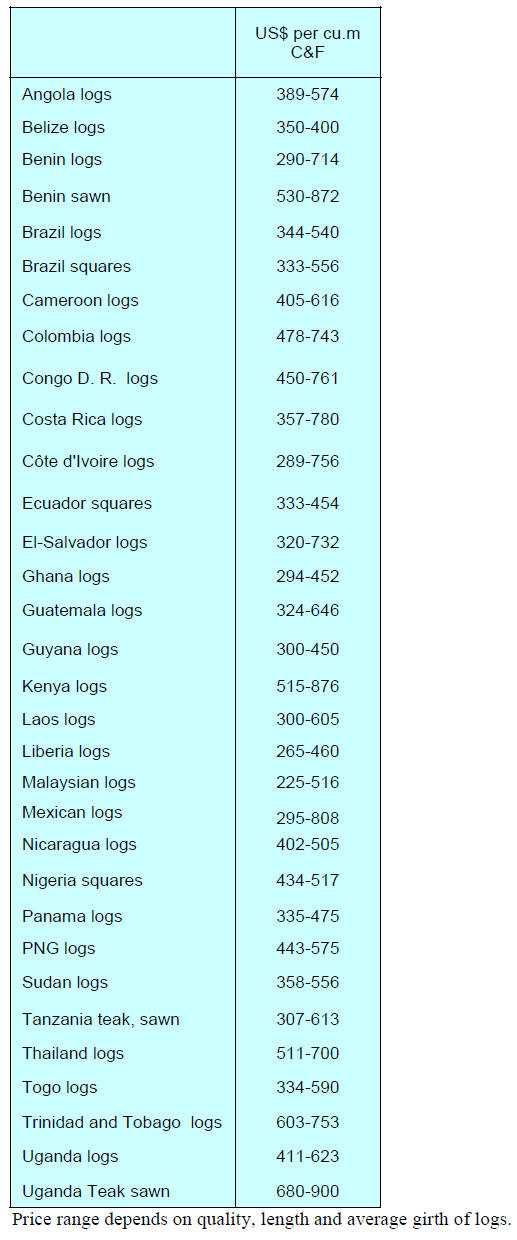
As was the case in mid-November, prices from the
three
new plantation teak log suppliers remain unchanged
at:Taiwan P.o.C (US$1036 to 2126 per cu.m C&F) and
Honduras (US$471 to US$539 per cu.m C&F). Sawn teak
from China (US$855 to 1118 per cu.m C&F) and from
Myanmar (US$461-2895 per cu.m C&F).
Prices for locally sawn imported hardwoods
Price levels have not changed since the increases reported
for mid-November.

Myanmar teak flitches resawn in India
Steady supplies of sawn teak from Myanmar and China
are keeping prices stable.
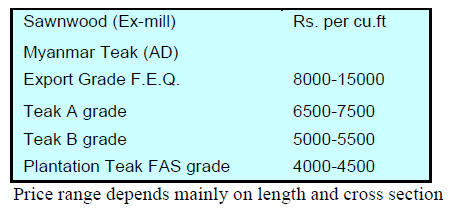
Prices for imported sawnwood
Traders report that demand for imported sawnwood has
started to improve but there have been no recent price
increases.
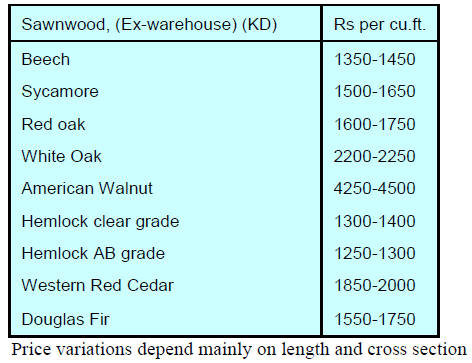
Prices for WBP Marine grade plywood from domestic
mills
Prices remain unchanged. The anticipated rise in plywood
prices as a result of the new Goods and Services Tax is yet
to materialise.
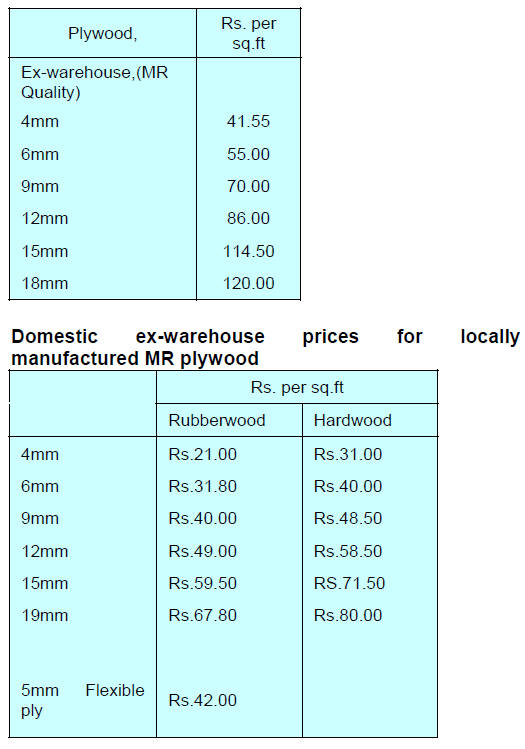
¡¡
8.
BRAZIL
Exporters fare better than companies
trading in the
domestic market
In an analysis of trade trends in Brazil¡¯s wood product
sector it has been observed that, while some sector of the
industry dedicated solely to the domestic market are facing
tough times, manufacturers focused on export markets
have managed better.
Brazil¡¯s exports of all wood products amounted to
US$201.4 million in September 2016 representing a
10.4% decline compared to a month earlier. Imports of
wood products totalled US$8.7 million in September down
just under 1% from the previous month.
The corresponding improvement in the wood product trade
balance was almost 11% in September 2016.
Between January to September 2016 wood product exports
totalled US$1,742.5 million up 0.4% year on year. Imports
over the same period totalled US$74.1 million and were
16% lower compared to the same period in 2015.
Despite the economic and political issues Brazil is
facing
exports values and the accumulated trade balance in 2016
are contributing to a recovery. According to ABIMCI it is
the decline in domestic building and construction that is
hurting companies focused on domestic sales while the
stronger US dollar has helped exporters.
Survival depends on finding new markets
In efforts to sustain their companies in the face of the
domestic economic downturn many are seeking alternative
markets overseas.
According to the Union of Timber and Furniture Industries
of Linhares and Northern Region of Espirito Santo State
(Sindimol) the sector has already lost about 10% of its
workforce as a consequence of the fall in sales. According
to the ¡°Brazil Furniture 2016" report the number of
persons employed in the furniture sector fell from 4,327 in
2014 to 3,770 in 2015.
The Linhares furniture cluster has 55 industries, 13% in
the State of Esp¨ªrito Santo, which has 434 furniture
factories. Production in 2015, according to the Brazil
Furniture 2016 report totalled 10.7 million pieces and the
value of this production was R$978.5 million, just under
2% of total Brazilian production.
Between October 26 and 28 this year many domestic
furniture companies participated in a furniture products
exhibition in Cuba. Participants discovered that Cuban
enterprises are actively seeking trading partnerships with
countries of South and Central America.
Export update
In October 2016 Brazilian exports of wood-based products
(except pulp and paper) increased 5.9% in value compared
to October 2015, from US$210.0 million to US$222.4
million.
Pine sawnwood exports increased 10.9% in value between
October 2015 (US$25.7 million) and October 2016
(US$28.5 million). Export volumes increased 20% over
the same period, from 121,900 cu.m to 146,700 cu.m.
In contrast, tropical sawnwood exports fell 18% from
31,900 cu.m in October 2015 to 26,100 cu.m in October
2016. The value of exports fell also but by a higher margin
dropping almost 20% from US$15.1 million to US$12.1
million over the same period.
In October, plywood exports increased year on year. Pine
plywood exports increased 14% in value in October 2016
in comparison to October 2015, i.e. from US$30.2 million
to US$34.5 million. Over the same period export volumes
increased almost 19% from 109,400 cu.m in October 2015
to 129,800 cu.m October this year.
There was a big jump in tropical plywood exports in
October as an 89% increase in the volume of exports was
achieved (7,500 cu.m in October 2015 to 14,200 cu.m in
October 2016).
The value of tropical plywood exports also rose (approx.
55%) from US$3.6 million in October last year to US$5.6
million.
However, the value of exports of wooden furniture fell in
October this year from US$36.7 million in October 2015
to US$ 35.6 million this October.
Brazilian wood industry sectoral study published
The Brazilian Association of Mechanically-Processed
Timber Industry (ABIMCI) published its 2016 Sectoral
Study in early November 2016. The sectors covered in the
study include plywood, sawnwood, wooden doors,
mouldings and wooden flooring.
This study reports that 57% of the jobs in the forest and
wood based industry sectors are in the processed wood
industries and that most of the industries are SMEs
producing a wide range of products mainly for the
domestic market.
The study provides information that can be used in a
practical way by industries, government and authorities to
assess business strategies and public policy plans that
contribute to the sector¡¯s development.
According to ABIMCI¡¯s evaluation the data show that,
despite difficulties caused by domestic economic crisis
and some challenges in the world timber markets, the
Brazilian industry continues to develop and is gaining
ground in international markets.
The timber sector has expectations for growth in the
domestic housing market which can grow significantly.
According to the Brazilian Institute of Geography and
Statistics (IBGE) the housing deficit in Brazil exceeds 5.8
million homes.
Among the priorities of ABIMCI are the need to expand
product certification, work on improvement and
development of technical standards, contribute to the
improvement of Brazilian wood exports, defend the
interests of the sector and promote sustainable practices
and transparency.
For more see: http://www.abimci.com.br/estudo-setorialapresenta-
perfil-da-industria-de-madeira-brasileira/
Timber exchange launched by BVRio
A private sector online trading platform the "Responsible
Timber Exchange" has been launched by an enterprise
named the BVRio Institute.
This trading platform aims to help buyers find wood
products from producers who can verify the legal origin of
their products or are offering products from certified
sources. In addition to B to B ¡®match-making¡¯ those
participating will have access to additional services that
add value to their transactions.
The timber exchange relies on integrated due
diligence
and a BVRio Risk Analysis system to facilitate tracking
along the supply chain. The objective, says BVRIO, is to
facilitate trade in responsibly sourced and manufactured
wood products while at the same time helping to promote
transparency, legality and sustainability in the timber
sector.
The exchange is designed to facilitate compliance with the
EU Timber Regulation and the Lacey Act as it offers the
means to identify timber products from legal sources in
Brazil, Indonesia (based on FLEGT license) as well as
those that have FSC and PEFC certification.
The company website says ¡°The BVRio Madeira
Exchange is a trading platform that promotes trade in
forest products of legal origin or certified wood (e.g.
FSC®) creating transparency, efficiency and liquidity to
this market. The platform is integrated to a risk analysis
system to assist in the due diligence process of each batch
of traded wood.¡±
For more see: http://bvrio.org/
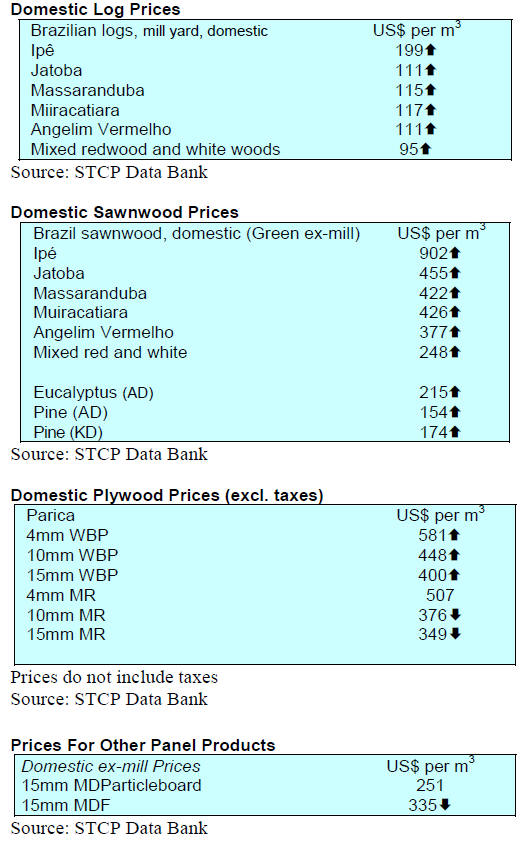
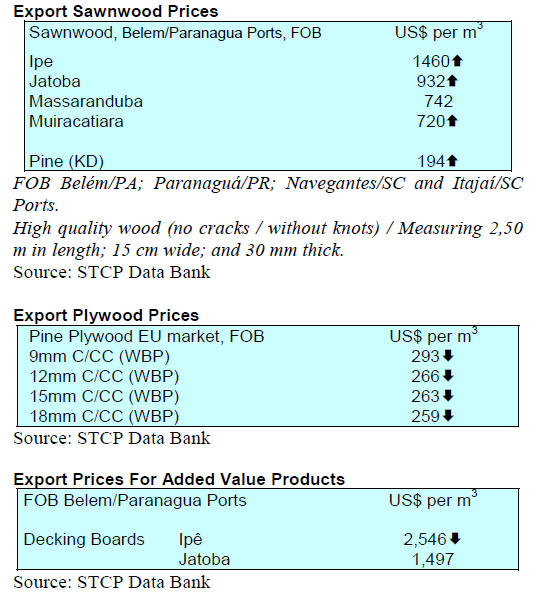
9. PERU
Peruvian government plans reforestation
in Amazonia
Peru¡¯s President Pedro Pablo Kuczynski announced during
a visit to the Amazonian town of Puerto Inca, located in
the region of Hu¨¢nuco 410 kilometres from Lima, that his
government plans reforestation of two million hectares of
Amazon. This plan has two major aims; maintenance of
ecosystem balance in the Amazon and strengthening of
development in the region.
The people of Peru, said the President, are spread across
both the Andean and Amazonian areas but geography
makes communication difficult and this must be
addressed. He said shortening distances between the
valleys of Peru, between workers and entrepreneurs,
between the people and their leaders is of vital importance
to ensure plans for social and economic integration
succeed.
Peru to host ITTC in 2017
During the 52nd International Tropical Timber Council
(ITTC) meeting in Japan Peru¡¯s invitation to host the next
Council meeting in Lima was unanimously welcomed.
The ITTC brings together representatives of all members
of the ITTO.
Action to address forestry and timber trade issues
Representatives of the Governments of Peru and the
United States met this month to exchange information on
progress with the Peru - United States Trade Promotion
Agreement (TPA) and discussed progress on issues in the
annex to this agreement on forest sector governance which
attracts support under the United States-Peru
Environmental Cooperation Agreement (ECA).
For the full joint meeting press release see:
https://ustr.gov/about-us/policy-offices/press-office/pressreleases/
2016/november/joint-statement-meetings-peru-us
The Peruvian Government highlighted actions it has taken
as part of its domestic agenda to strengthen the forestry
sector, such as: the implementation of the National System
on Forest and Wildlife Management (SINAFOR), the
National System of Control and Surveillance on Forest
and Wildlife (SNCVFFS), the Management Information
System created by OSINFOR (SIGO), the National Pact
for Legal Timber, the Legislative Decrees N¡ã 1220, which
establishes measures to fight against illegal logging, and
N¡ã 1237 which modifies the Peruvian criminal code to
increase penalties for forest crimes, among others actions.
Peru announced unilateral actions that will be
implemented promptly as part of its domestic agenda to
address on-going challenges regarding timber export
products and strengthen the forestry sector:
Amend export documentation requirements by the end
of the first quarter in 2017 to include additional
information to improve traceability throughout the
supply chain;
Implement the National Information System on Forest
and Wildlife ¨C Control Module (SNIFFS-MC) in the
Amazon corridor (Loreto, Ucayali, Huanuco and
Lima) by the end of the first quarter of 2017 and
continue to enrich information in the system and
advance its progressive implementation in 2017;
Implement measures to promote legal trade of timber
products through: 1) risk-based measures for
prevention and timely detection of illegally harvested
timber, including inspections by OSINFOR prior to
commercialization for export, and 2) promoting the
use of voluntary mechanisms for improving due
diligence in the exports of timber products, such as
the National Pact for Legal Timber and inspections by
OSINFOR upon request prior to commercialization
for export;
Improve the accuracy of annual management plans,
including by strengthening the capacity of regional
governments to conduct visual inspections prior to
POA approval, and ensuring that forest regents are
promptly removed from the national registry of
regents for wrong-doing in accordance with Peruvian
legislation;
Take measures to ensure that regional governments
promptly transfer annual operating plans to the
appropriate authorities in accordance with Peruvian
legislation;
Determine the responsibilities of those involved in the
timber shipment subject to the verification and impose
sanctions, in accordance with Peruvian legislation.
